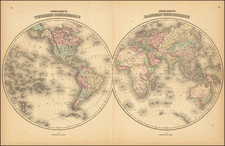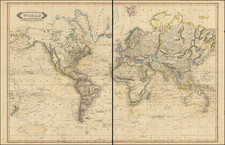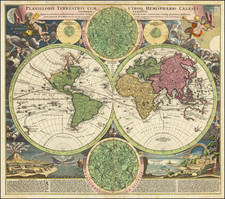Early Photographic Facsimile of One of the Rarest Early World Maps.
Early photographic reproduction of the of Contarini-Rosselli world map from the collection of early map scholar Edward Luther Stevenson.
Shirley (24) says of the map:
Since the early 1490s, when Rosselli's world map showing the rounding of southern Africa was printed, there had been a decade and a half of the most far-ranging explorations. Some findings from these exciting discoveries had been recorded on vellum portolan charts of which only one or two survive today, such as the chart by Juan de la Cosa attributed to 1500 and the Cantino world map of c.1502. No printed maps of this era depict any of the new explorations until the years 1506-1507 when three original world maps independently appeared. These are the great world maps of Contarini-Rosselli, Johann Ruysch, and Martin Waldseemuller.
The world map designed by Giovanni Matteo Contarini and engraved by Francesco Rosselli was first discovered in 1922 and is now in the British Library. The map is an elegant copper engraving on a fan-shaped or coniform projection and was printed in either Venice or Florence. The date of the map (1506) and the names of the designer and engraver are indicated in a Latin inscription just east of the Cape of Good Hope.
For the first time on a map the newly-discovered relationship between the east and the west parts of the world is set out. The breadth of the Pacific Ocean remains too small compared to the rest of the world and it is still assumed that North America is an easterly extension of Asia. This large promontary, stretching across what is now the north Atlantic, is marked as being part of the province of Tangut, mentioned by Marco Polo. Off its eastern tip (where now is Newfoundland) an inscription refers to the land discovered by the seamen of Portugal - a reference to the exploration of the Corte-Reals in 1500 and 1501. The West Indian islands are shown in detail as ' ... the islands which Master Christopher Columbus discovered at the instance of the most serene King of Spain.' No coastline is marked west of Cuba, implying that Contarini chose to ignore Vespucci's alleged voyages in this area in 1497. To the south, present-day South America is separated from North America by a wide strait but its northern coast is plotted in detail, based on the discoveries of Columbus in 1498 and Amerigo Vespucci in 1499-1500. To the southwest and south-east undiscovered land extends to the map's limits. However, a large legend off the coast of Asia refers to Columbus' last voyage (of 1502-1504) and his having reached Ciamba, searching for gold. Whether this relates to the province of Cianba, marked on the mainland of Asia, or perhaps indirectly to the island of Zinpangu (Japan) in the middle of the Pacific, is not clear.
Africa is now surprisingly well-delineated, showing the whole of the east coast but the interior details are pure speculation. For the first time India appears as a peninsula with the designation of Calicut and other cities reached by Vasco da Gama and later by Cabral in the early 1500s. Madagascar and its adjacent island Zanzibar are greatly exaggerated in size. Further east, the rest of Asia still follows Ptolemaic lines.
Nothing is known of the designer Contarini, although in another inscription on the map he refers to himself as 'famed in the Ptolemaean art.' No other maps by him are extant. Rosselli's hand as the engraver - if he were not named in the imprint - would certainly be inferred by reference to his other known works. As to the map's sources, there is no strong affinity with anyone known original and it is probable that several manuscripts or portolan charts were used. Detailed analysis of the place names shows that, in respect of America, they are derived in almost equal proportions from the charts by La Cosa, Cantino and Caverio. It has therefore been suggested that Contarini and/or Rosselli used a composite source document, of Spanish or Portuguese origin, no longer in existence today.
The Edward Luther Stevenson Collection
Edward Luther Stevenson was among the most important scholars of early cartography active at the end of the 19th century and the first half of the 20th. He was responsible for numerous cartobibliographic books, including the first translation of Ptolemy to English, as well as a series of impressive facsimile maps produced while he was at the Hispanic Society of New York. Dr. Stevenson viewed facsimiles as integral to the study of early cartography, and he committed himself to building an unparalleled collection of photographs of early maps and globes. Much of his collection was donated to Yale University after his death (click on the title link above for about that), but the present item comes from a large collection of photos, manuscripts, and related material that were part of Stevenson's library, but were not donated to Yale. It is truly an impressive collection and many of the items, though reproductions, have serious antiquarian merit. As Alexander O. Vietor said about Stevenson collection that went to Yale "this is the stuff of which great libraries are made."












![[ Pre-Columbian World Map; ] Secunda etas mundi](https://storage.googleapis.com/raremaps/img/small/98195.jpg)
![[Eastern Hemisphere] Le Globe Terrestre Represente En Deux Plans-Hemispheres . . . 1740](https://storage.googleapis.com/raremaps/img/small/92751.jpg)


